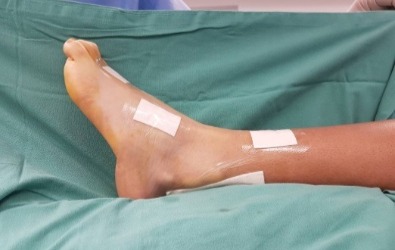
Neuromuscular pathologies and Syndromes are:

Commonly seen syndromes in our clinic include:
1.Charcot Marie Tooth: It is a neurological condition that causes deformities in the extremities and spine. The orthopedic surgeon is called upon to deal with the problems that occur in walking due to severe deformities in the feet such as pes cavus (high arch foot) and toe deformities soles. Deformities tend to get worse over time. For this reason, it is best to correct the deformity in the early stages of the pathology when the foot is flexible, in an attempt to avoid fixed bony deformities and complex surgical interventions.
The photos show pre and post-operative x-rays of a patient of ours with Charcot Marie Tooth and a high arch foot.

Pre-operative

Post-operative
2.Arthrogryposis: Arthrogryposis: It is a rare congenital syndrome, which presents with deformities in many parts of the body (trunk and limbs). Surgical intervention is often required for hip dislocation and lower limb deformities. In some cases, Arthrogryposis is accompanied by club foot; at our clinic we successfully applied the Ponseti method on a number of cases with arthrogryposis and club feet, thus avoiding complex surgeries.

3. Duchenne Muscular Dystrophy (DMD): Duchenne muscular dystrophy is a severe form of muscular dystrophy that affects boys. It is the most common inherited muscular disease in childhood. Usually children in the early years have a normal gait and tend to present later on with a worsening gait. Treatment for tip toe walking is often required for this condition.



4. Spinal Muscular Atrophy: Spinal muscular atrophy is caused by a genetic abnormality and affects the function of muscles in children. It is sub-classified into 4 types depending on the onset and severity of the disease. Depending on the severity it presents to the orthopaedic surgeons with limb muscle weakness, inability or difficulty walking, dislocated hips and trunk and limb deformities. Dr. Zenios has published an article with extensive research on spinal muscular atrophy and hip dislocation. (read article)
5.Ostogenesis imperfecta: It is a condition in which children present with recurrent fractures, usually without significant injury, due to bone weakness. The severity of the pathology varies from child to child depending on its classification. Due to multiple fractures children often develop deformities. As well as medical treatment with bisphosphonates, these children often need specialized orthopedic interventions in order to stabilize fractures and correct and prevent deformities.

The image shows a case of severe Ostogenesis
imperfecta, which required insertion of growing rods in both thigh and leg
bones in an attempt to limit deformities.
6. Spina bifida: It is the result of a deformity that develops in the spine of the fetus during pregnancy. It can affect the mobility and is characterized by abnormal development of the spinal cord in the spine. The higher the spinal cord lesion, the more severe the deformities. Its incidence rates are declining worldwide due to folic acid administration to pregnant women. However, there are still some cases with the above condition presenting with peripheral neuropathy and deformities in the lower extremities.
The figure below shows typical feet deformities in spina bifida
